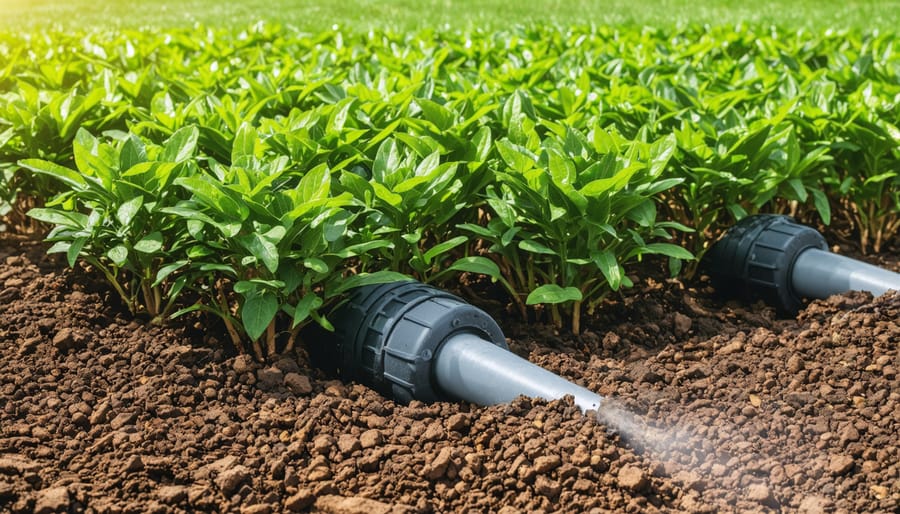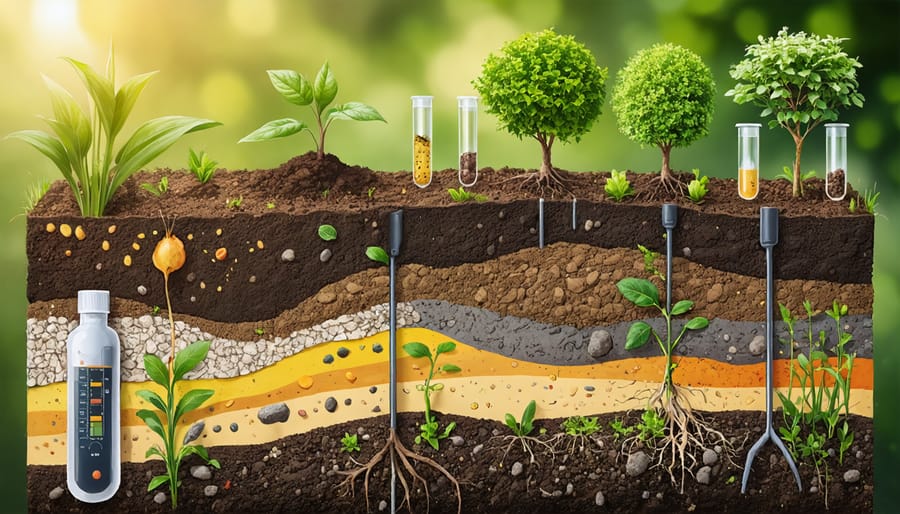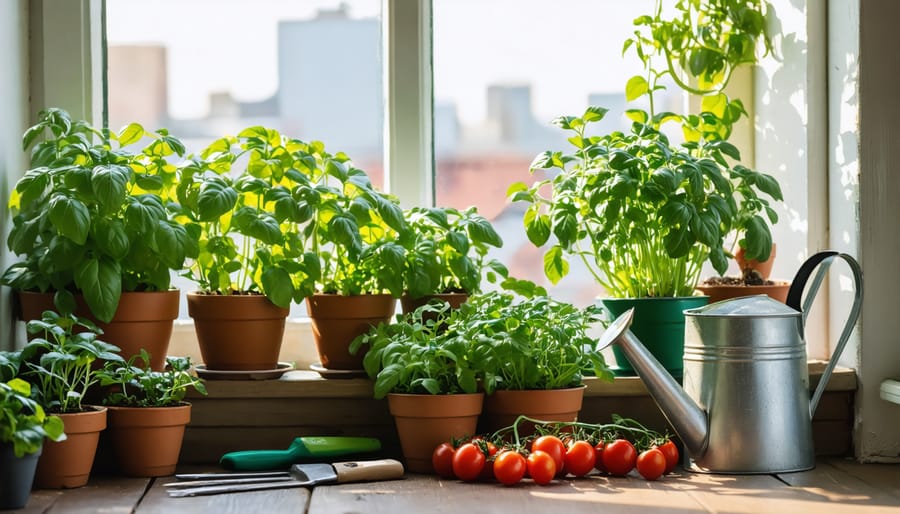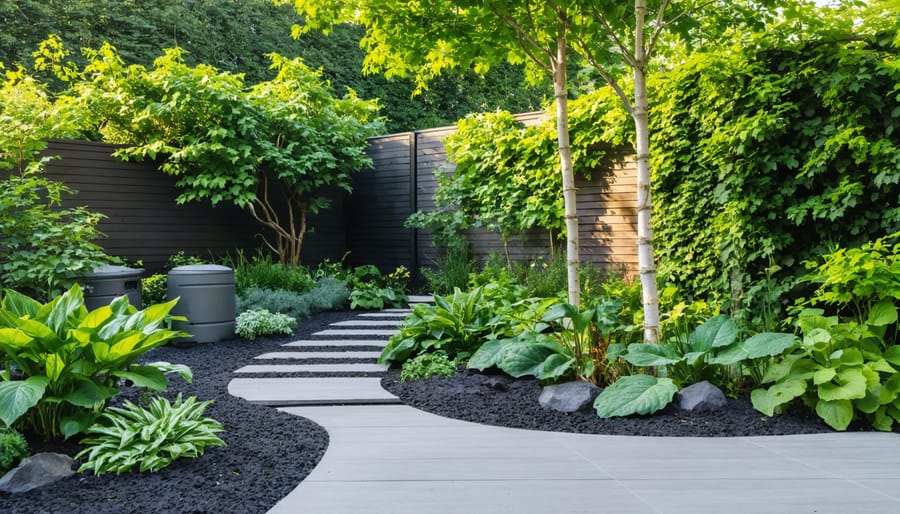Transform your backyard into a thriving food oasis by choosing to start your first vegetable garden today. Map your garden’s location based on 6-8 hours of direct sunlight, enriching the soil with organic compost three weeks before planting. Test soil pH levels between 6.0 and 7.0 for optimal nutrient absorption, then select vegetables that match your growing zone and seasonal timing.
Growing your own food revolutionizes your relationship with nature while providing fresh, nutritious produce steps from your kitchen. Master gardeners worldwide confirm that successful vegetable gardens thrive on three fundamental principles: proper soil preparation, strategic plant spacing, and consistent watering schedules. Whether you’re cultivating a small herb collection in containers or planning a full-scale vegetable plot, these time-tested techniques ensure bountiful harvests throughout the growing season.
Recent studies show home vegetable gardens yield an average $677 worth of produce annually per household, making this rewarding hobby both spiritually and financially enriching. By following proven growing methods and embracing seasonal rhythms, you’ll join millions of successful gardeners in cultivating sustainable, organic food sources right outside your door.
Planning Your Vegetable Garden for Success
Choosing the Perfect Location
Selecting the right location for your vegetable garden is crucial for success. The three key factors to consider are sunlight, soil quality, and available space. Most vegetables need 6-8 hours of direct sunlight daily to thrive, so observe your yard throughout the day to identify the sunniest spots. South-facing areas typically receive the most sunlight and are ideal for sun-loving crops like tomatoes and peppers.
Good soil is the foundation of a healthy garden. The best soil for vegetables is well-draining, rich in organic matter, and has a loose, crumbly texture. Before settling on a location, grab a handful of soil and perform a simple squeeze test – if it holds shape when squeezed but crumbles easily when poked, you’re in good shape. If your soil needs work, don’t worry – most soil can be improved with compost and organic amendments.
When considering space, remember that you don’t need a huge yard to grow vegetables. Even a small 4×8 foot raised bed can produce an impressive harvest. Ensure your chosen spot has easy access to water and is convenient for daily maintenance. Avoid areas where water pools after rain or locations too close to trees whose roots might compete with your vegetables for nutrients.
Consider starting small and expanding gradually as you gain experience. It’s better to maintain a small, productive garden than to feel overwhelmed by a large one. Remember, vertical growing options can help maximize limited space.
Designing Your Garden Layout
A well-designed garden layout is the foundation of a successful vegetable garden. Start by sketching your garden on paper, considering the sun’s path across your space. Most vegetables need 6-8 hours of direct sunlight daily, so plan to position taller plants like tomatoes and corn on the north side to prevent them from shading shorter plants.
Make the most of your space by implementing smart companion planting strategies. For instance, plant basil near tomatoes to enhance their flavor and repel pests, or grow carrots alongside onions to maximize space usage while naturally deterring garden pests.
Create paths that are wide enough for comfortable access – about 18-24 inches between beds is ideal. If you’re working with raised beds, keep them no wider than 4 feet so you can easily reach the center from either side. For in-ground gardens, consider creating permanent beds with clearly defined walking paths to prevent soil compaction.
Remember to group plants with similar water needs together to make irrigation more efficient. Plant frequently harvested vegetables like lettuce and herbs closer to your house for easy access. Leave some space for succession planting, where you can add new crops as others finish producing, ensuring a continuous harvest throughout the growing season.
Finally, don’t forget to include vertical growing options like trellises and cages for vining plants such as cucumbers and pole beans. This approach not only saves space but also makes harvesting easier and keeps fruits clean and disease-free.

Soil Preparation: The Foundation of Garden Success
Testing and Amending Your Soil
Testing your soil is like taking its temperature – it tells you exactly what your garden needs to thrive. Start by collecting soil samples from different areas of your garden, about 6 inches deep. You can purchase a soil testing kit from your local garden center or send samples to your county extension office for a detailed analysis.
A basic soil test reveals your soil’s pH level and nutrient content. Most vegetables prefer slightly acidic soil with a pH between 6.0 and 6.8. If your soil is too acidic, add limestone to raise the pH. For alkaline soil, sulfur or organic matter like pine needles can help lower the pH.
Once you know what your soil needs, it’s time to make improvements. Organic matter is your best friend here. Work in compost, aged manure, or leaf mold to improve soil structure and add nutrients. As a general rule, mix in 2-3 inches of organic matter across your garden bed.
For specific nutrient deficiencies, choose appropriate amendments:
– Low nitrogen: Add blood meal or composted manure
– Low phosphorus: Incorporate bone meal or rock phosphate
– Low potassium: Mix in wood ashes or greensand
Remember to amend your soil gradually rather than all at once. Too many amendments can overwhelm your plants and disturb the soil’s natural balance. Work additions into the top 8-12 inches of soil about two weeks before planting, and let the soil rest before introducing your vegetables.
Test your soil annually, preferably in spring before planting. This helps you track improvements and adjust your amendment strategy as needed.

Building Healthy Garden Beds
The foundation of a thriving vegetable garden lies in the quality of your garden beds. Whether you’re building raised beds or improving existing soil, creating the right growing environment is crucial for your plants’ success.
For raised beds, start with a sturdy frame made from untreated cedar or composite materials, ensuring a minimum depth of 12 inches for most vegetables. Layer your bed with a mix of 60% topsoil, 30% compost, and 10% well-rotted manure to create a rich growing medium. This combination provides excellent drainage while retaining essential nutrients.
If you’re working with existing garden soil, begin by conducting a simple soil test to determine its pH and nutrient levels. Most vegetables thrive in slightly acidic soil with a pH between 6.0 and 6.8. Improve heavy clay soil by incorporating organic matter like compost, leaf mold, or aged manure. For sandy soil, add plenty of compost to help retain moisture and nutrients.
Remember to avoid compacting your soil by creating dedicated paths between beds. Use mulch or straw in these walkways to prevent weed growth and maintain soil structure. Each spring, rejuvenate your beds by adding a fresh layer of compost and working it gently into the top few inches of soil.
For the best results, practice crop rotation and consider adding cover crops during the off-season to naturally enrich your soil. These simple but effective practices will help build healthy, productive garden beds that will support your vegetables for years to come.
Choosing and Planting Your Vegetables
Best Vegetables for Beginners
Starting your vegetable garden doesn’t have to be overwhelming. These tried-and-true vegetables are perfect for beginners, offering high success rates and relatively quick harvests. Let’s explore some of the most reliable options for your first garden.
Leafy greens like lettuce and spinach are fantastic starter vegetables. They grow quickly, can be harvested continuously, and don’t require much space. You can start seeing results in as little as 30 days, which is incredibly rewarding for new gardeners.
Cherry tomatoes are another excellent choice. While they need a bit more attention than leafy greens, they’re more forgiving than their larger cousins and produce abundantly throughout the season. Just remember to provide support with stakes or cages as they grow.
Bush beans are practically foolproof. They don’t need trellising, produce within 50-60 days, and can handle various soil conditions. Plus, kids love helping to harvest these easy-growing vegetables!
Radishes deserve special mention for impatient gardeners. These speedy vegetables can go from seed to harvest in just 20-30 days. They’re also great for succession planting, meaning you can sow new seeds every two weeks for continuous harvests.
Zucchini and summer squash are known for their impressive yields – sometimes too impressive! One or two plants can easily feed a family throughout the season. They grow quickly and don’t require special attention beyond regular watering.
For root vegetables, try carrots. While they take a bit longer to mature, they’re relatively low-maintenance once established. Just ensure your soil is loose and free from rocks for straight, healthy roots.
Green onions (scallions) round out our beginner-friendly list. They’re quick to grow, can be harvested at any size, and add fresh flavor to your meals year-round. They’re also perfect for container gardening if you’re short on space.
Remember, success with these vegetables builds confidence and provides valuable experience for tackling more challenging crops in the future.

Planting Techniques and Timing
Success in vegetable gardening often comes down to proper timing and technique. The best time to plant depends on your local climate and the specific vegetables you’re growing. Generally, cool-season crops like lettuce, peas, and broccoli should go into the ground as soon as the soil can be worked in early spring. Warm-season vegetables such as tomatoes, peppers, and cucumbers need to wait until after the last frost date.
When it comes to planting technique, preparation is key. Start by loosening the soil to a depth of at least 12 inches, incorporating organic matter as you go. For direct-sown seeds, create furrows at the proper depth (usually indicated on the seed packet) using the edge of a garden trowel. A good rule of thumb is to plant seeds at a depth of about three times their diameter.
For transplants, dig holes slightly larger than the root ball and gently place the plant at the same depth it was growing in its container. Tomatoes are an exception – they can be planted deeper as they’ll develop roots along their buried stem. Water thoroughly after planting to help settle the soil around the roots.
Consider succession planting for continuous harvests throughout the season. Plant short rows of quick-growing vegetables like radishes, lettuce, and bush beans every two weeks rather than all at once. This strategy ensures a steady supply of fresh vegetables rather than a single large harvest.
Proper spacing is crucial for healthy growth. While it’s tempting to squeeze in more plants, overcrowding leads to competition for nutrients and increased disease risk. Follow spacing guidelines on seed packets or plant labels, and thin seedlings as needed. Remember, a few healthy, well-spaced plants will yield more than many crowded ones.
Remember to plant tall crops on the north side of your garden to prevent them from shading shorter plants. And always keep a garden journal to track planting dates and successes – this information becomes invaluable for planning future growing seasons.
Essential Maintenance Tips
Watering and Mulching Strategies
Water is the lifeblood of your vegetable garden, but knowing when and how much to water can make the difference between thriving plants and disappointing yields. The key is to water deeply and less frequently, rather than giving your plants frequent shallow drinks. This encourages roots to grow deeper, making your plants more resilient during dry spells.
First, invest in proper watering equipment that allows for gentle, controlled irrigation. A watering wand or soaker hose works wonderfully for delivering water directly to the soil without splashing leaves, which can lead to fungal issues.
The best time to water is early morning, when temperatures are cool and there’s less evaporation. This gives plants plenty of time to dry before evening, reducing disease risks. During hot summer months, check soil moisture by inserting your finger about 2 inches deep – if it feels dry at that depth, it’s time to water.
Mulching is your secret weapon for water conservation. Apply a 2-3 inch layer of organic mulch around your vegetables, keeping it slightly away from plant stems. Straw, leaves, or grass clippings work beautifully and help maintain consistent soil moisture while suppressing weeds. As these materials break down, they’ll also enrich your soil.
Different vegetables have varying water needs throughout their growth cycle. For example, tomatoes need consistent moisture during fruit development, while root vegetables like carrots prefer slightly drier conditions once established. Consider grouping plants with similar water requirements together to make irrigation more efficient.
Remember to water the soil, not the plants themselves. This targeted approach delivers moisture where it’s needed most – at the roots – and helps prevent water-related problems like leaf scorching or mildew. In particularly hot weather, you might need to water twice daily, but always check the soil moisture first rather than sticking to a rigid schedule.

Managing Pests and Diseases Naturally
Keeping your vegetable garden free from pests and diseases doesn’t mean you need to resort to harsh chemicals. Nature provides numerous effective solutions that work in harmony with your garden’s ecosystem. One of the best defenses is companion planting – try growing marigolds alongside your tomatoes to repel nematodes, or plant basil near your peppers to ward off various insects.
Creating a diverse garden environment attracts beneficial insects like ladybugs, praying mantises, and parasitic wasps, which naturally control pest populations. You can encourage these helpful creatures by adding flowering herbs and native plants throughout your vegetable beds.
For common pest issues, try these gentle yet effective solutions: Mix one tablespoon of neem oil with a quart of water to create a natural insecticide spray. For slugs, place shallow dishes of beer in your garden – they’re attracted to the yeast and will fall in. Coffee grounds scattered around plants can deter both slugs and cats while adding nutrients to your soil.
Disease prevention starts with good garden practices. Ensure proper spacing between plants to promote air circulation, and water at the base of plants rather than from above to prevent fungal issues. Remove any diseased leaves promptly and add them to a separate compost pile or dispose of them away from your garden.
Building healthy soil is your best defense against both pests and diseases. Add compost regularly and practice crop rotation to prevent soil-borne diseases from taking hold. A thick layer of organic mulch helps maintain soil moisture while creating barriers against certain pests.
For larger pests like rabbits or deer, physical barriers work best. Installing a simple fence or using row covers can protect your precious vegetables without harming wildlife. Remember, a few holes in leaves aren’t always cause for alarm – a healthy garden can typically withstand some pest activity without significant crop loss.
Starting your own vegetable garden is a rewarding journey that connects you with nature, provides fresh, nutritious food for your table, and brings a sense of accomplishment that’s hard to match. As we’ve explored throughout this guide, successful vegetable gardening comes down to a few key principles: thoughtful planning, proper soil preparation, smart plant selection, and consistent maintenance.
Remember that every garden, like every gardener, is unique. Don’t be afraid to experiment and learn from both your successes and challenges. Start small with a few favorite vegetables, and gradually expand as your confidence grows. The beauty of gardening is that there’s always something new to learn and try, whether you’re a complete beginner or have been tending plants for decades.
Keep in mind that patience is essential – Rome wasn’t built in a day, and neither is a thriving garden. Focus on building healthy soil, establishing good watering habits, and staying on top of basic maintenance tasks. Your garden will reward you with better yields and fewer problems over time.
Most importantly, enjoy the process! There’s something magical about planting a tiny seed and watching it grow into food for your table. Whether you have acres of land or just a few containers on your patio, your vegetable garden can become a source of joy, learning, and fresh, delicious produce for years to come.
So grab your gardening tools, get your hands dirty, and start growing your own vegetable paradise today. Your future self will thank you for taking this first step toward a more sustainable and satisfying lifestyle.




